 Home
Gallery
Contact
Events & Projects
Projects: 2019 On
Film & TV
Archive & Links
Home
Gallery
Contact
Events & Projects
Projects: 2019 On
Film & TV
Archive & Links
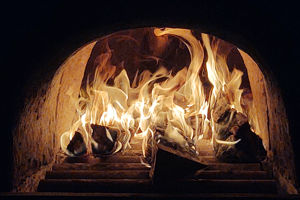
 Home
Gallery
Contact
Events & Projects
Projects: 2019 On
Film & TV
Archive & Links
Home
Gallery
Contact
Events & Projects
Projects: 2019 On
Film & TV
Archive & Links
|

|
2021 Furnace ('Phoenix') and Lehr at Quarley - 'Phoenix' Firing Two - Glassblowing
Projects: 2019 Onwards
Woodshed Build
The Woodpile
IFoG Furnace Removal
Firepit Reconstruction
Furnace Superstructure Build
Phoenix Firing One
Repairs after Firing One
Phoenix Firing Two
Repairs after Firing Two
------------------------------------------------
Furnace Performance and Lehr Pots, Collars and Breakages Glassblowing
|
Glassblowing
Post-medieval Beaker The diamond pattern is created using a 'pineapple mould'. As there is a lot of undercut in the mould, the glassblower has to inflate the glass in the mould hard and fast, suck to slightly deflate it, then pull the bubble out before it cools and stiffens too much. The glassblower also has to work quickly and accurately in order to create a successful prunt with a sharply-stamped pattern. |
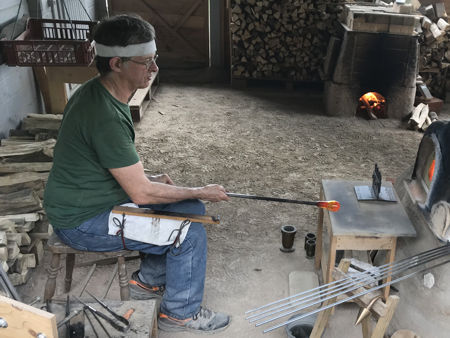
|
|
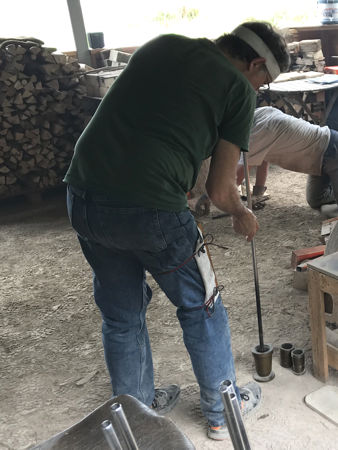
|
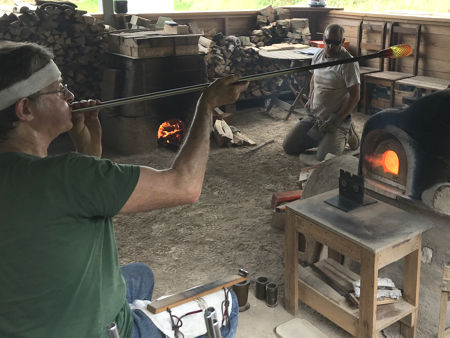
|
|
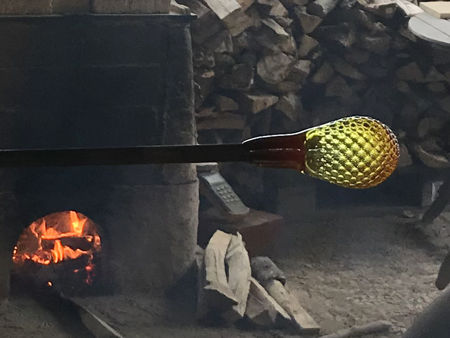
|
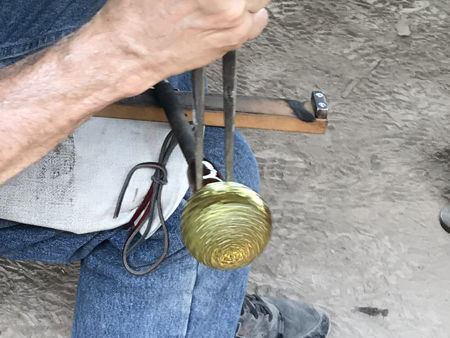
|
|
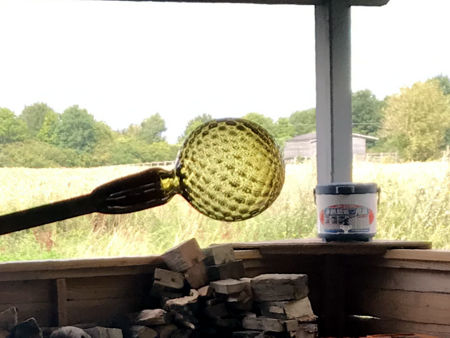
|
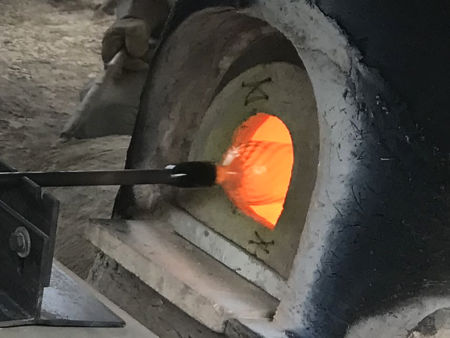
|
|
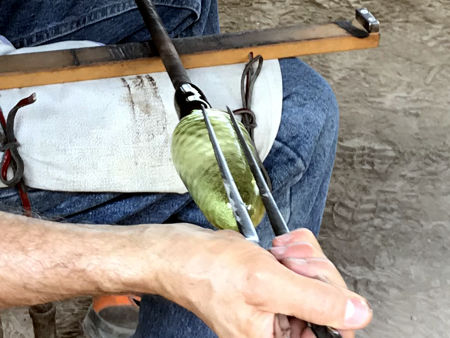
|
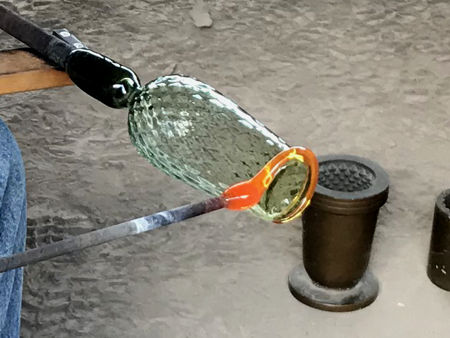
|
|
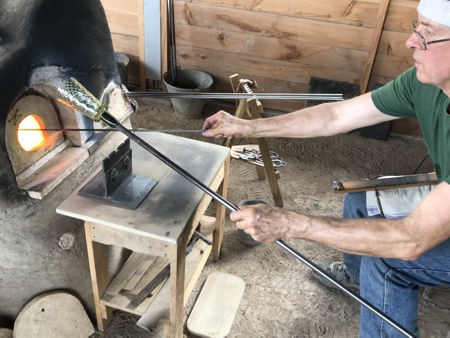
|
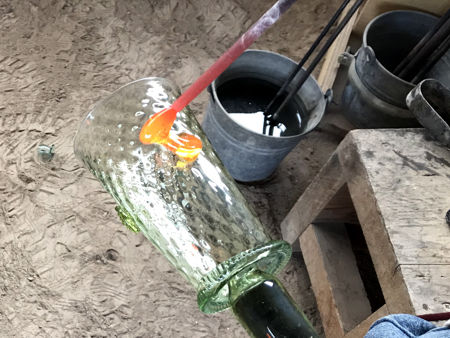
|
|
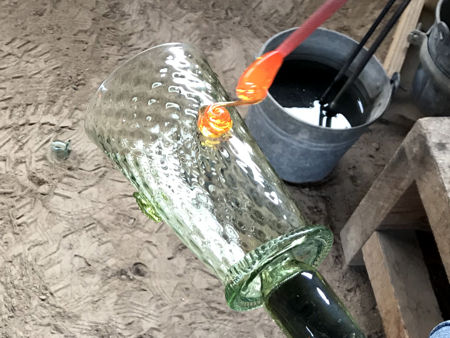
|
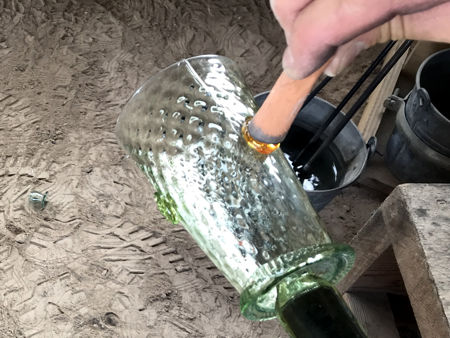
|
|
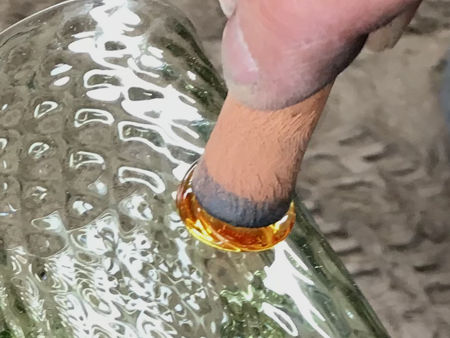
|
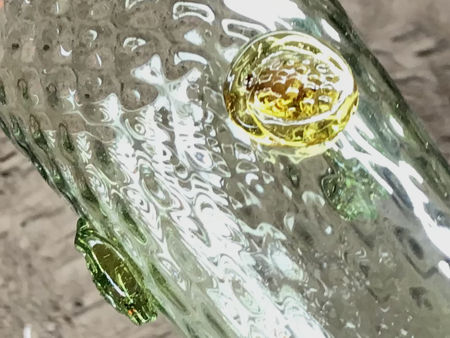
|
|
|
Post-medieval Goblet
The first part of the process is similar to forming the Post-medieval Beaker: using a 'pineapple mould' and elongating the bubble. When adding the bubbles for the stem and foot, an assistant is very useful, though not entirely necessary. We know several glassblowers who will do this on their own. Note that Mark is using the shears in his left hand for guiding and shearing the bubble. Even though he learned to blow glass right-handed, he still finds using his left hand more natural for some operations. In the photos of attaching the punty, one can see an extra coil of glass around the nose of the blowing iron. This is a hot glass 'wrap', added to add heat to the moile (the glass on the nose of the iron) without using the gathering hole for a reheat. This is not always necessary, but sometimes is needed to cut the risk of the moile becoming too cold and cracking. The crack can often travel down to the bowl, so needs to be guarded against. |
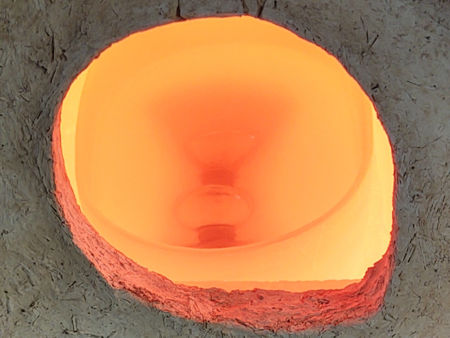
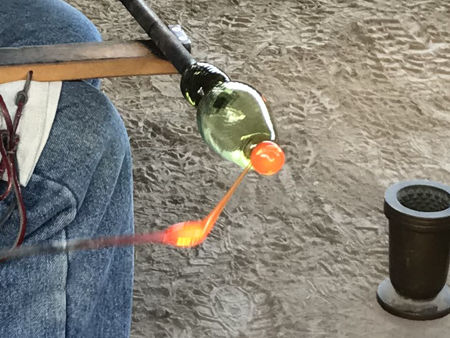
|
|
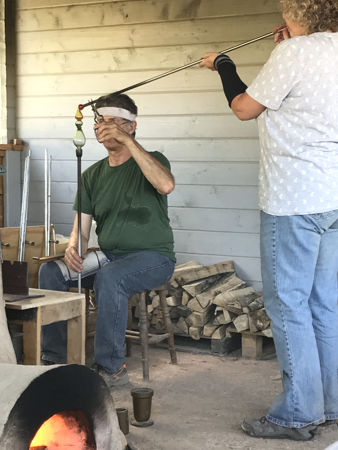
|
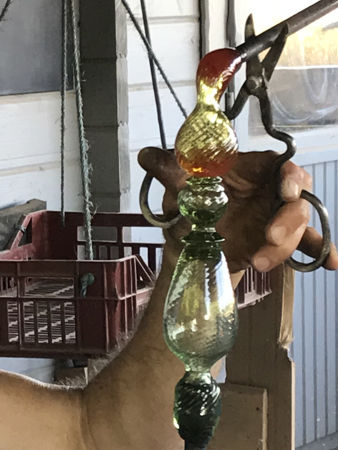
|
|
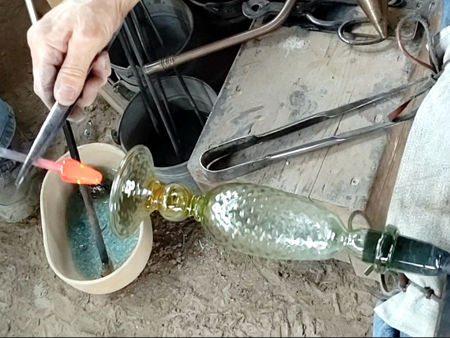
|
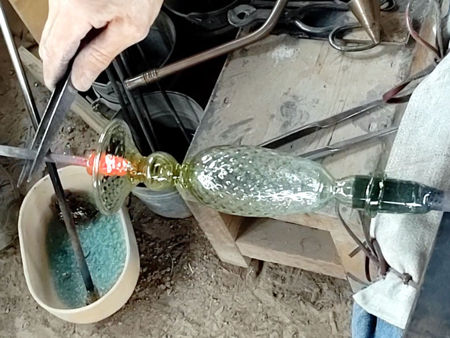
|
|
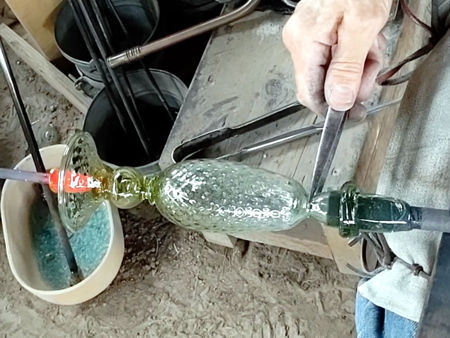
|
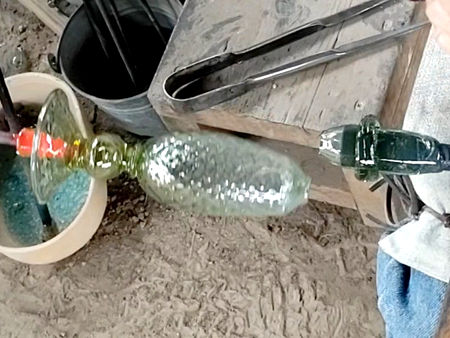
|
|
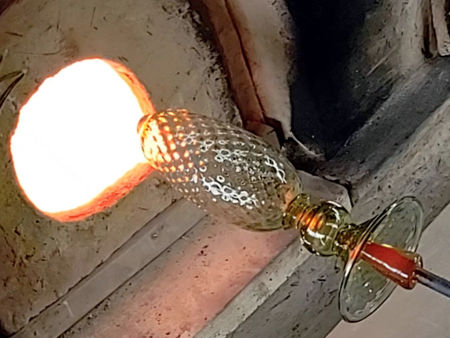
|
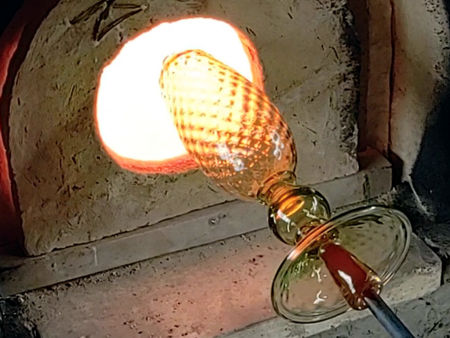
|
|
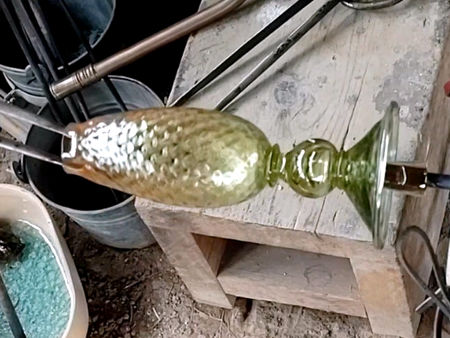
|
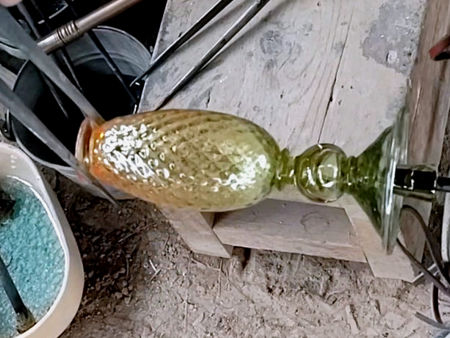
|
|
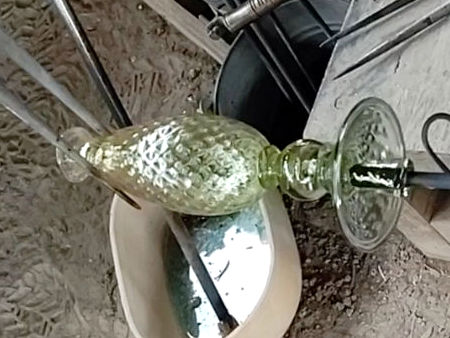
|
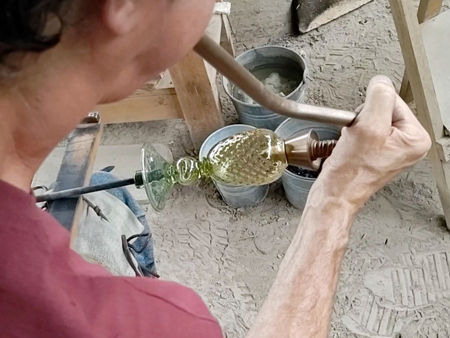
|
|
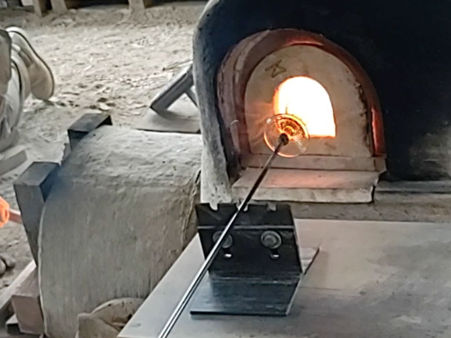
|
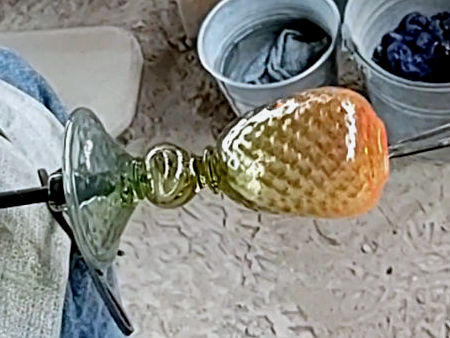
|
|
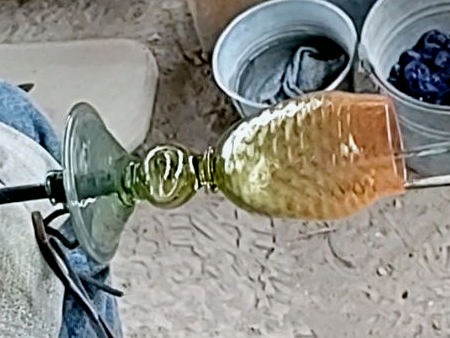
|
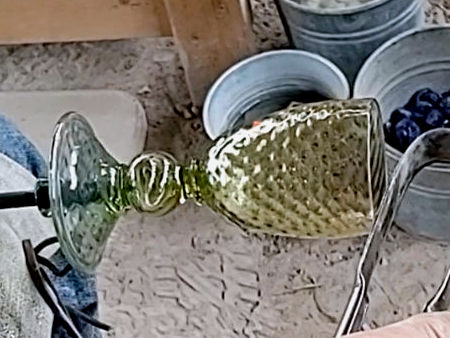
|
|
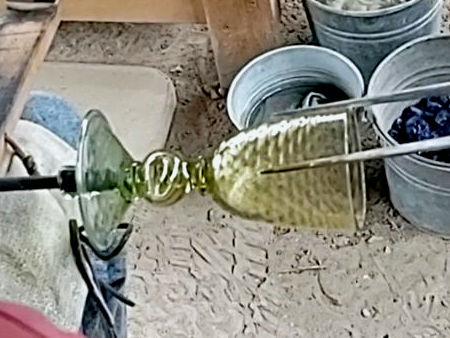
|
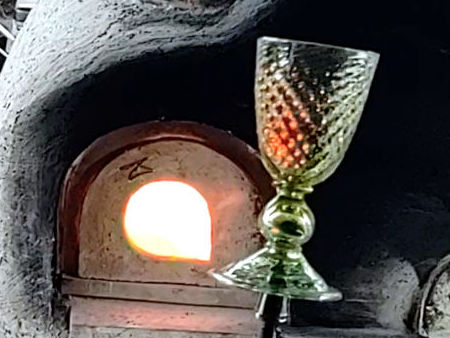
|
|
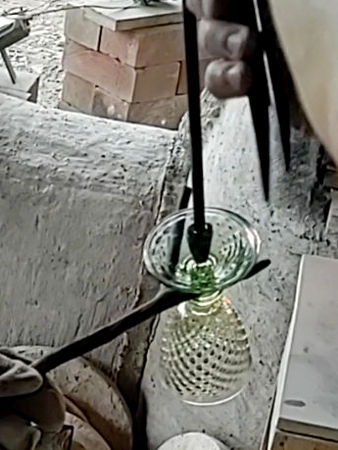
|
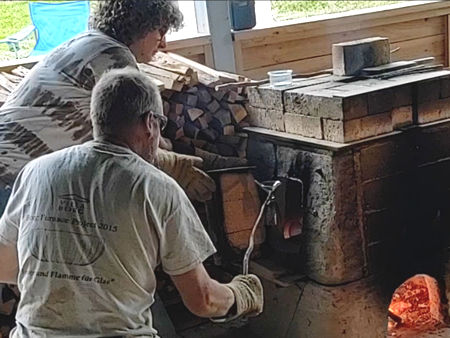
|
|
|
Footed Bowl
Note the jacks (tools), which are very long to enable them to open much wider than most jacks. They are made from a length of round steel rod bent in half. They are ground away just below the top until the tension of the spring is right. |
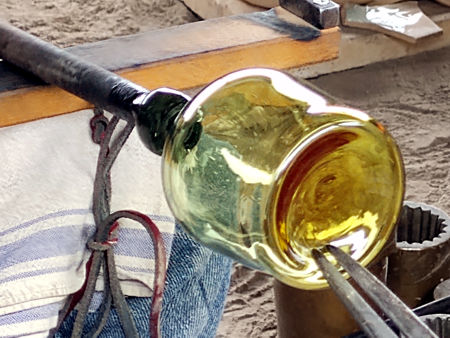
|
|
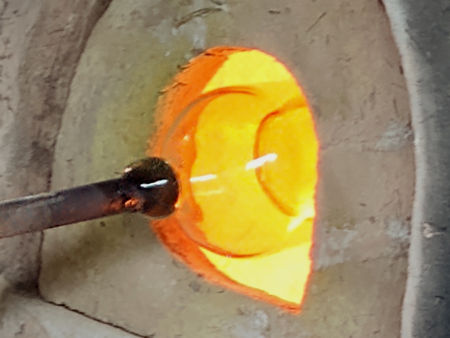
|
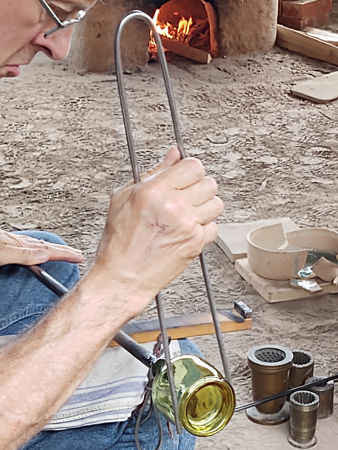
|
|
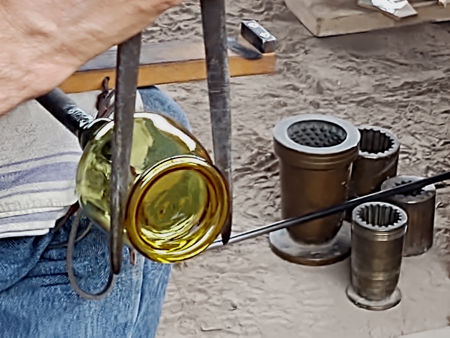
|
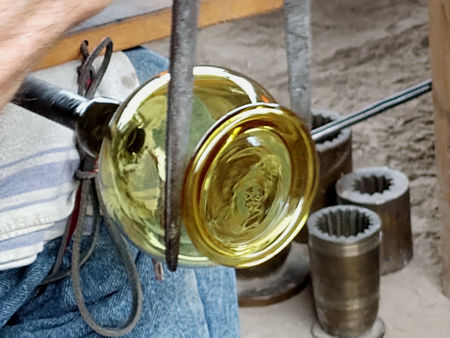
|
|
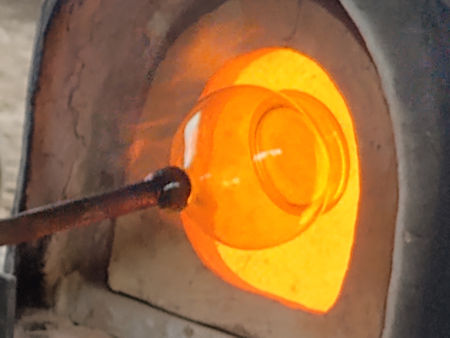
|
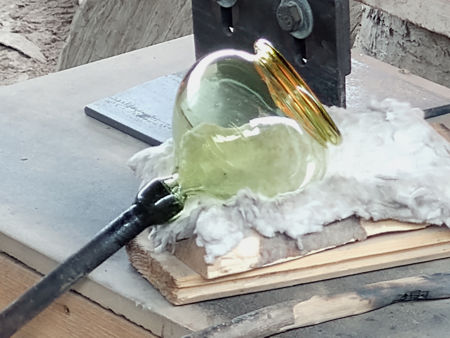
|
|
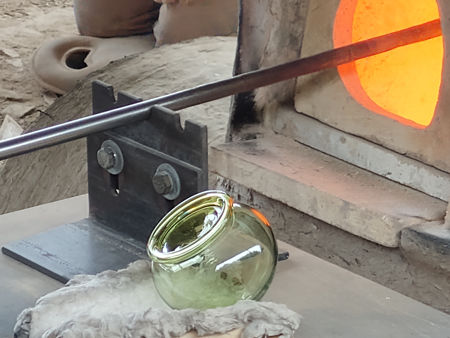
|
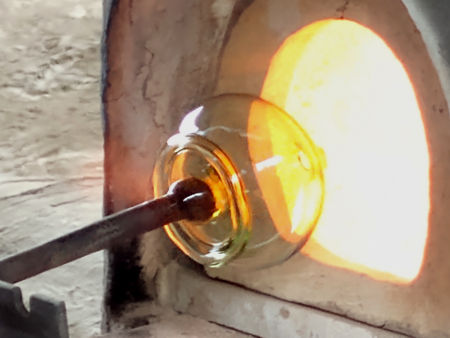
|
|
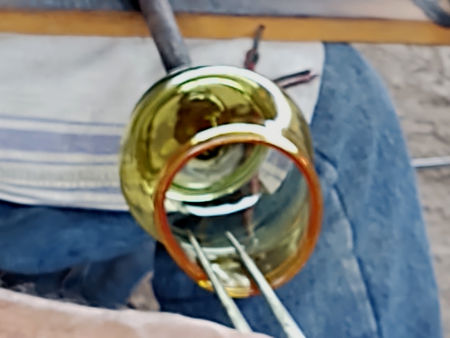
|
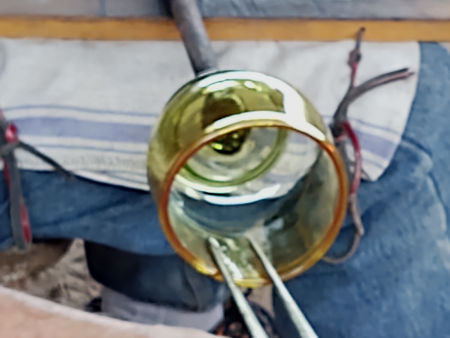
|
|
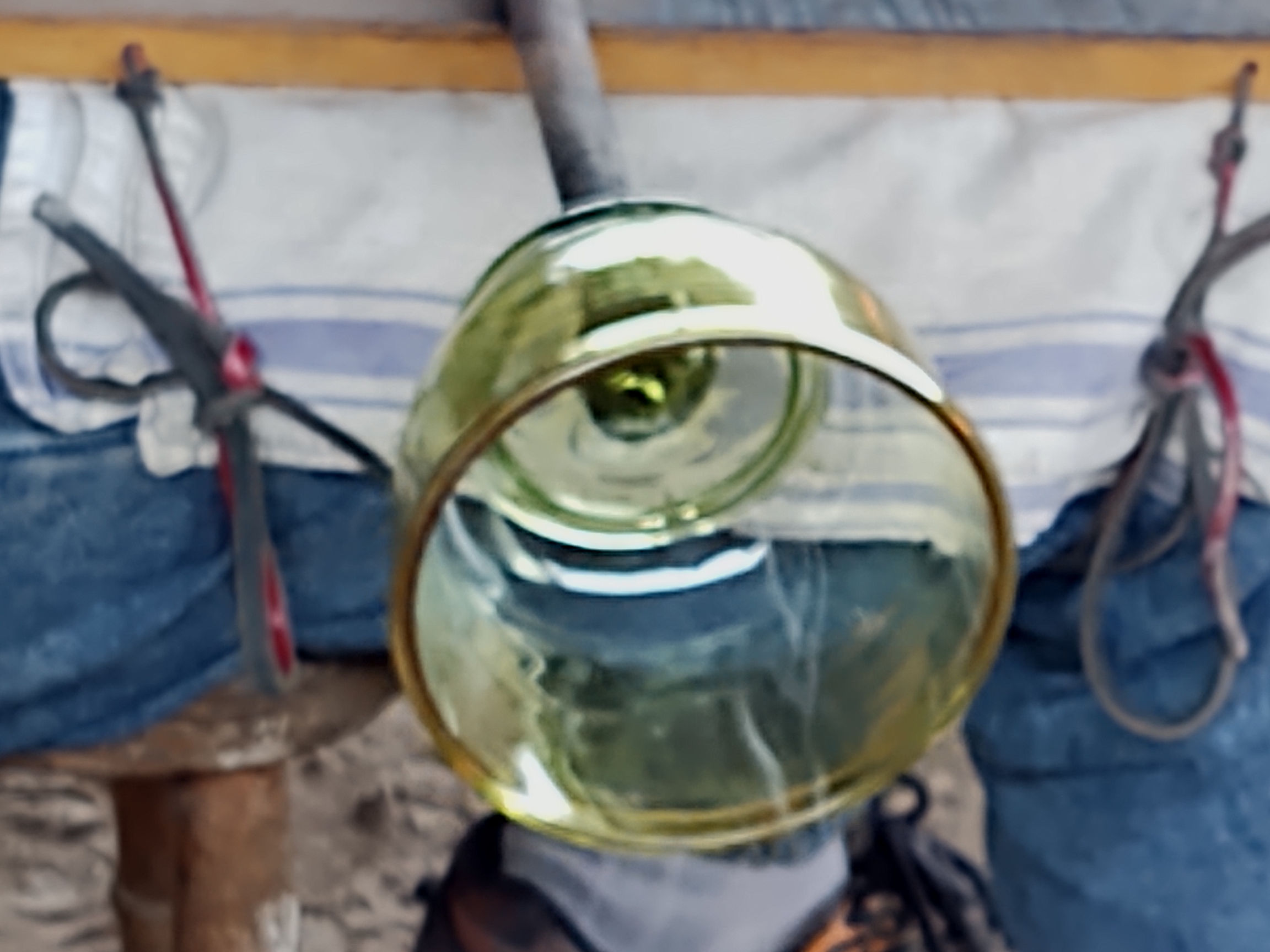
|
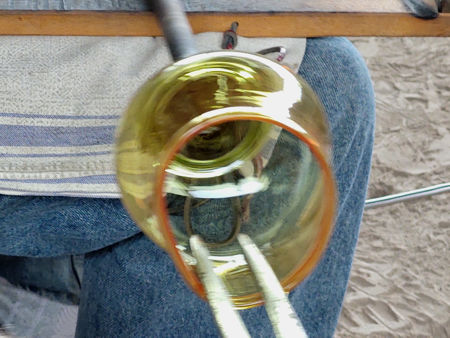
|
|
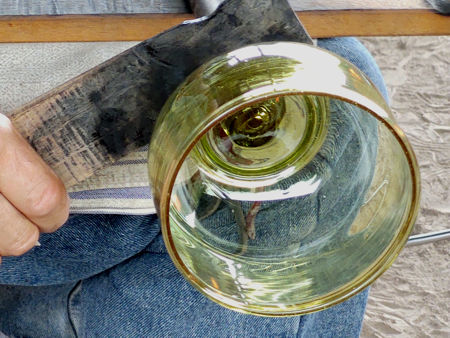
|
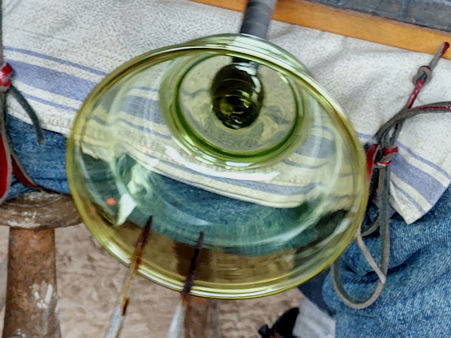
|
|
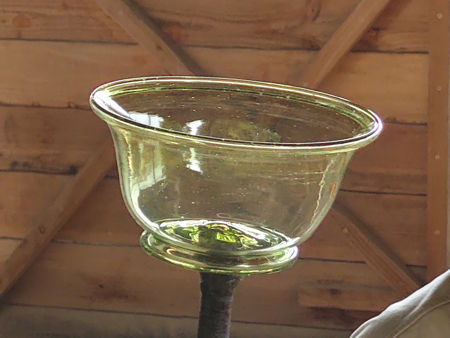
|
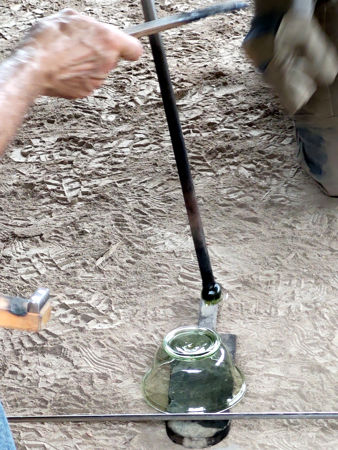
|
|
|
Cylindrical Bowl
Many of these Roman bowls don't have a folded rim. We've added the fold as it makes the bowl look more balanced as well as making the rim stronger and less susceptible to chipping. |
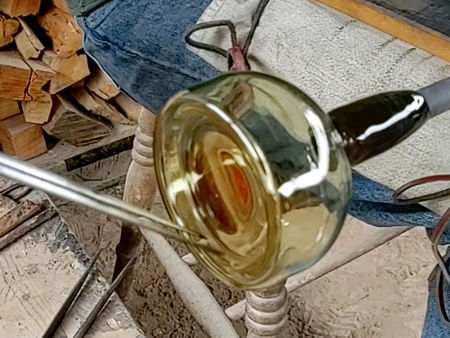
|
|
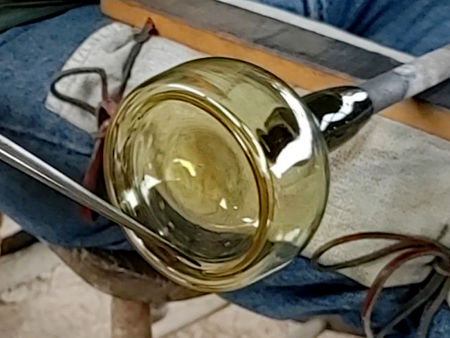
|
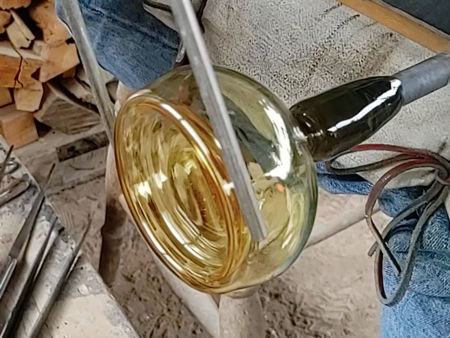
|
|
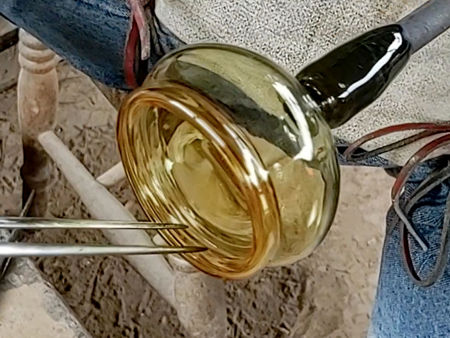
|
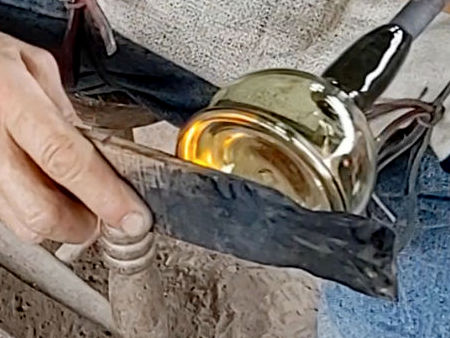
|
|
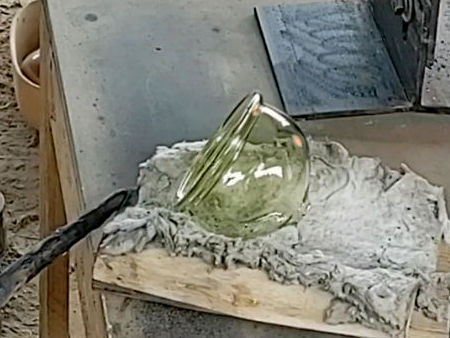
|
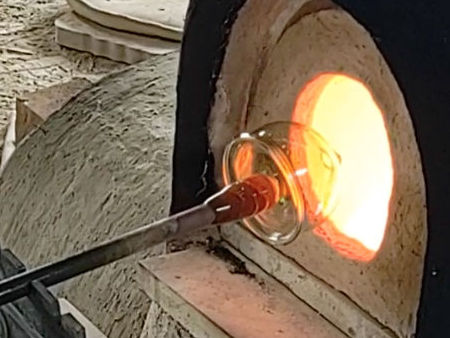
|
|
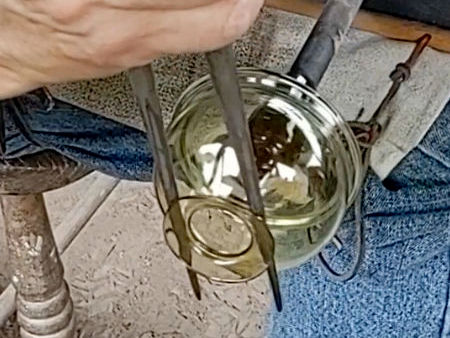
|
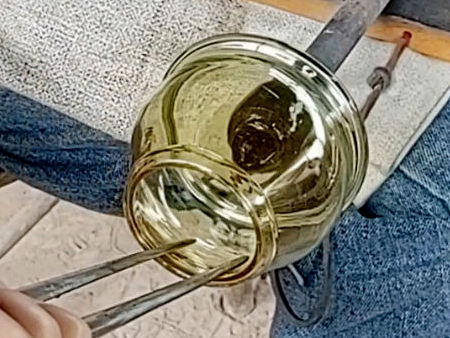
|
|
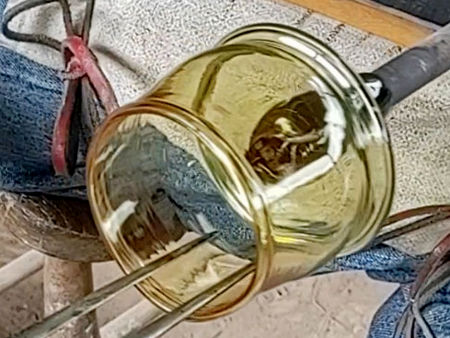
|
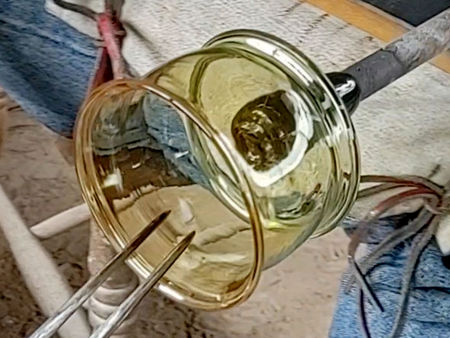
|
|
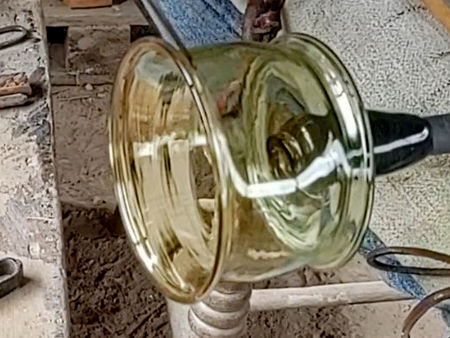
|
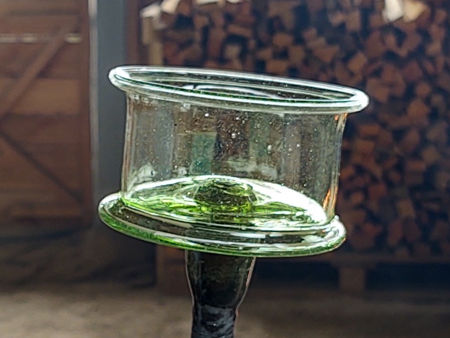
|
|
|
Kantharos
The kantharos is an interesting early Roman blown glass vessel shape (mid - late 1st century CE) in that the punty is made of the blown foot and the globular knop that forms the stem. This can be viewed as the precursor to the punty proper (it is also in evidence on the Ennion jugs - another early Roman vessel type). The moile is removed from the bottom of the foot when the vessel has cooled down. The bowl is inside cased, and the first gather is of opaque white glass. This can be seen on the blowing iron in the photos. |
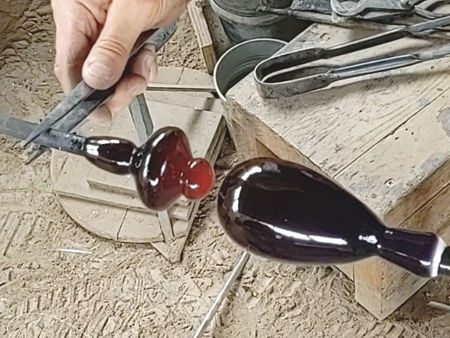
|
|
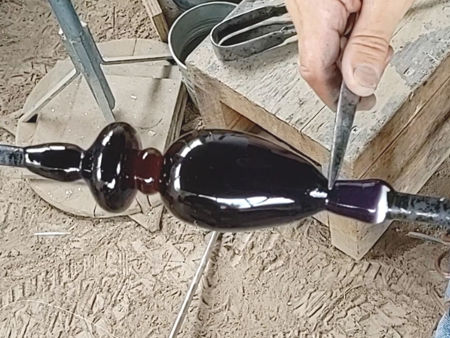
|
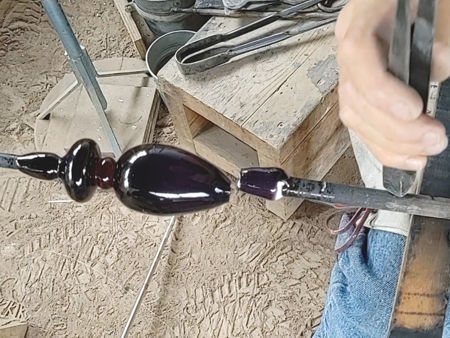
|
|
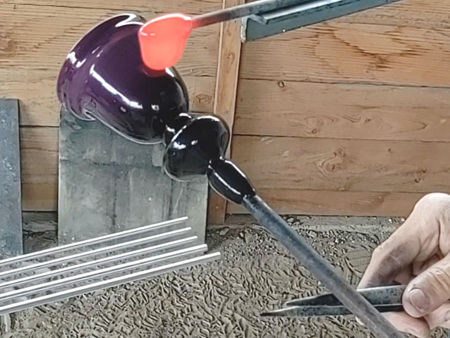
|
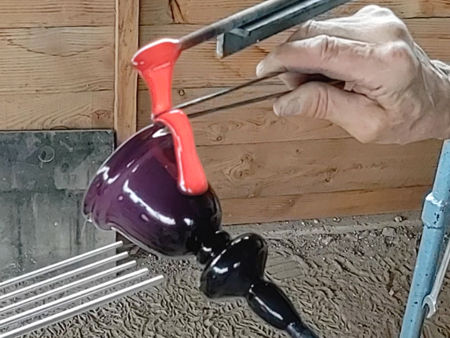
|
|
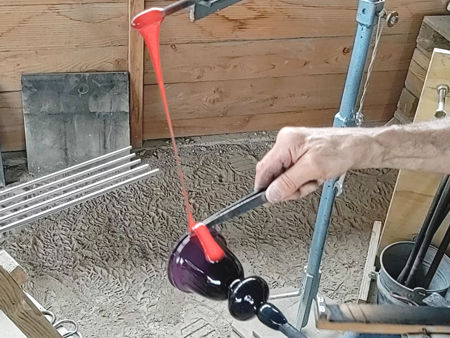
|
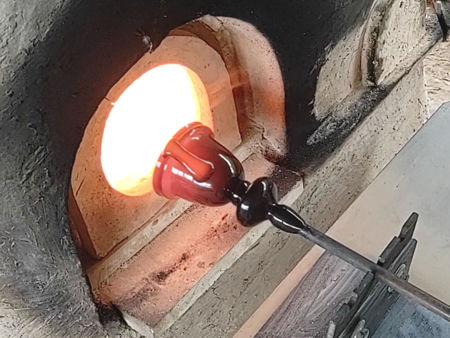
|
|
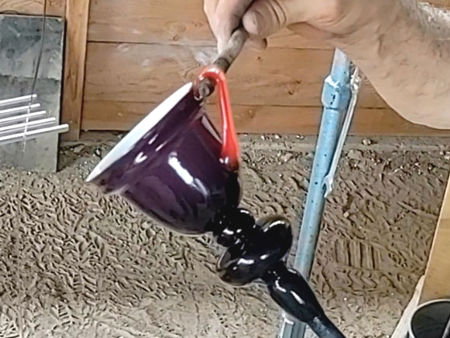
|
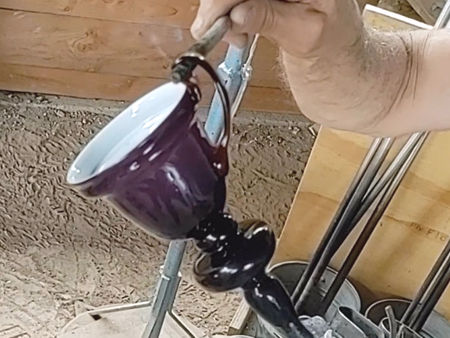
|
|
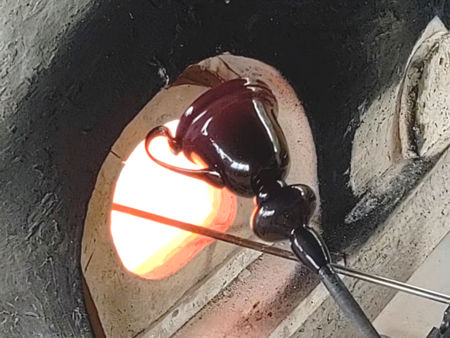
|
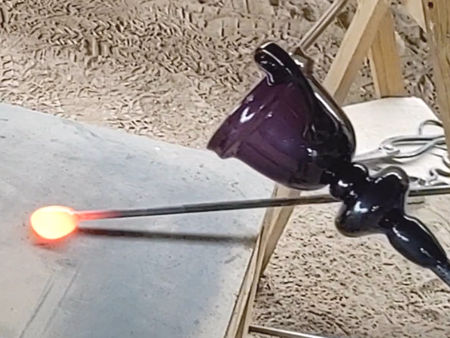
|
|
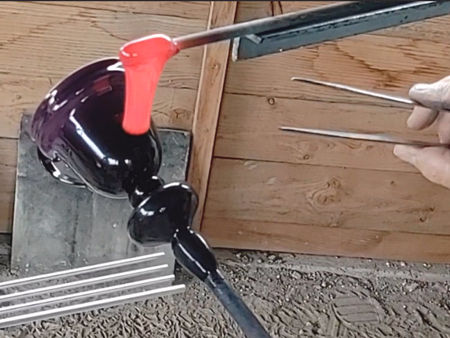
|
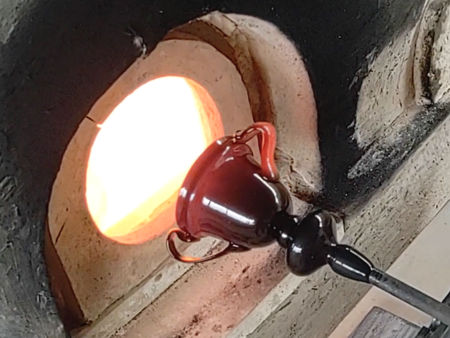
|
|
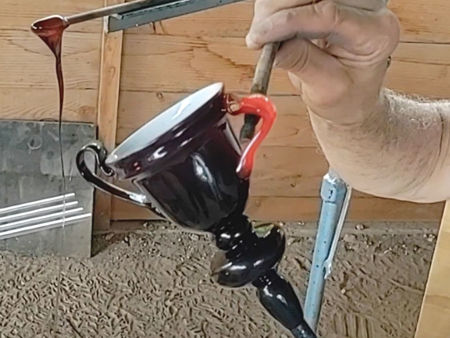
|
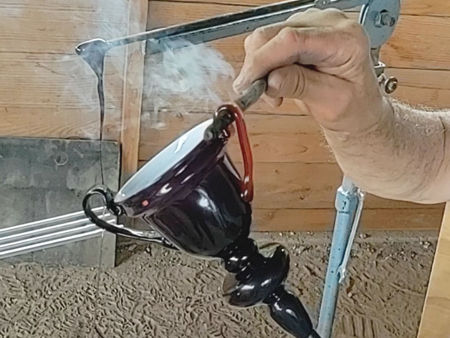
|
|
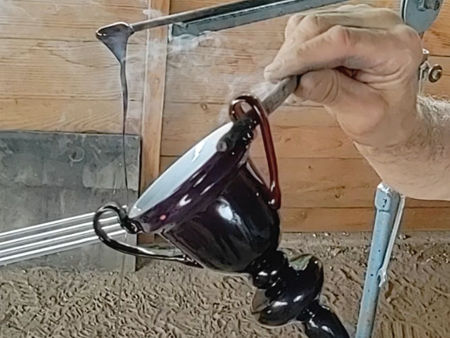
|
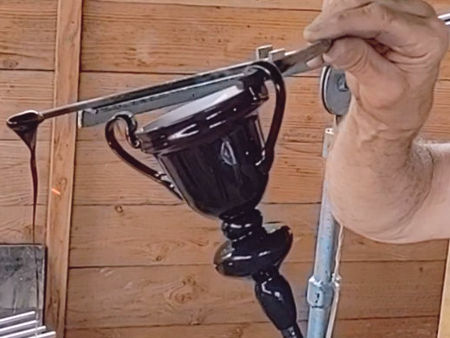
|
|
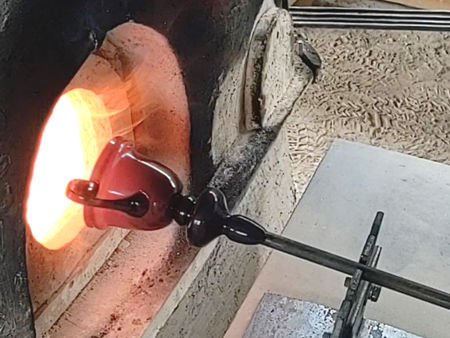
|
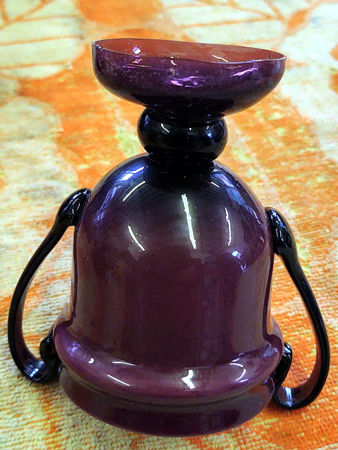
|
|
|
Piriform Bottle
This is essentially a Tall-necked Phial, but with a longer body. As with the phial, the neck is created by allowing the hot glass bubble to run under the influence of gravity, and is not physically stretched using the jacks. Similarly, the cut at the top of the shoulder is intentially made as a form of decoration, and is not due to using the jacks to stretch the neck. For the Tall-necked Phial, see this page from Phoenix Firing Two. |
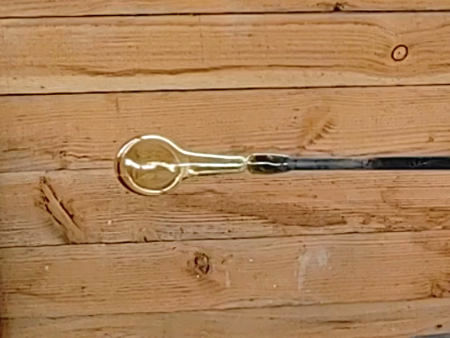
|
|
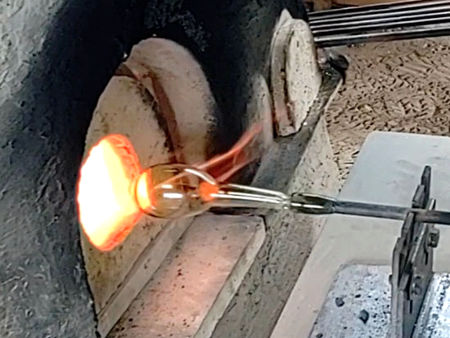
|
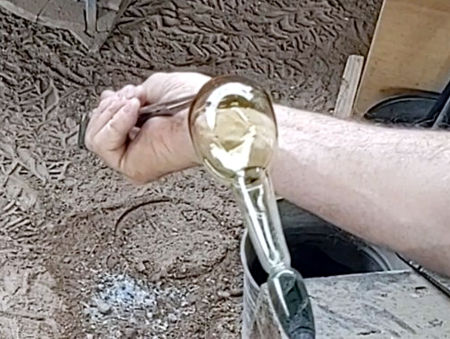
|
|
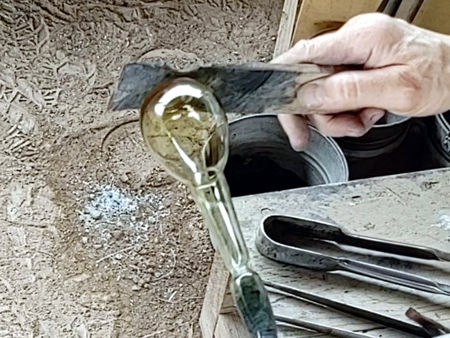
|
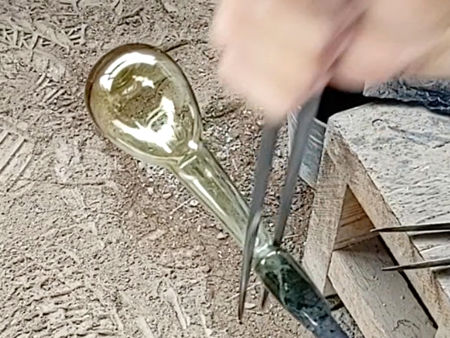
|
|
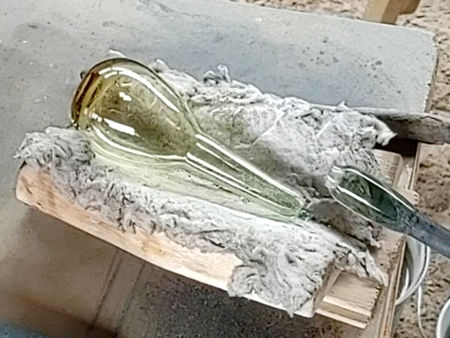
|
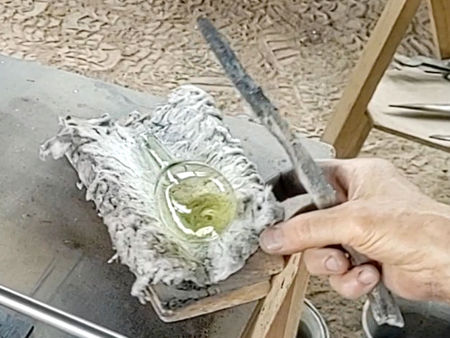
|
|
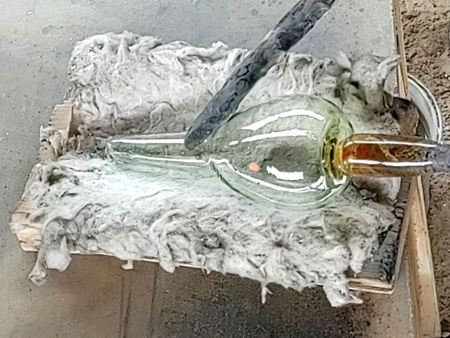
|
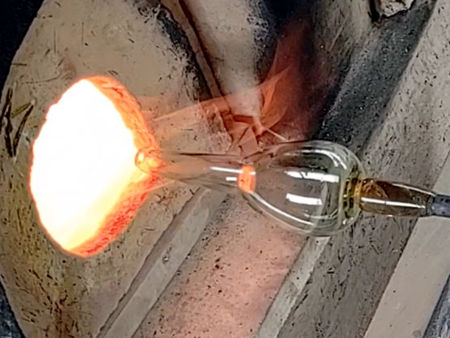
|
|
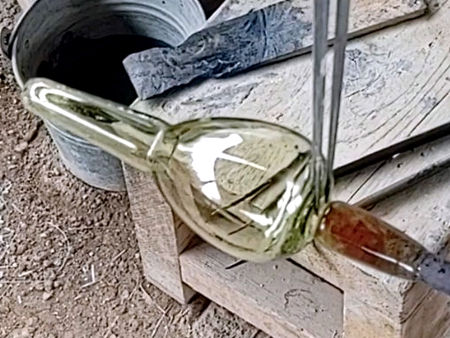
|
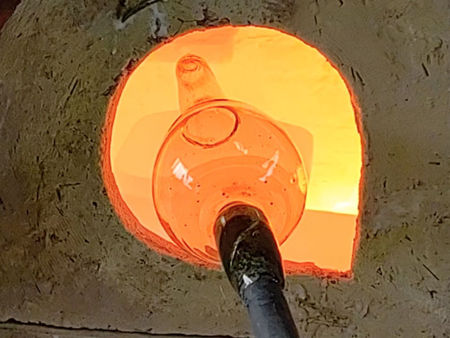
|
|
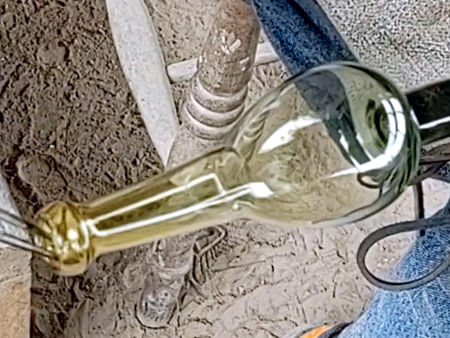
|
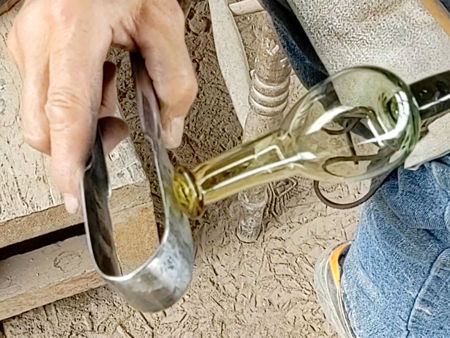
|
|
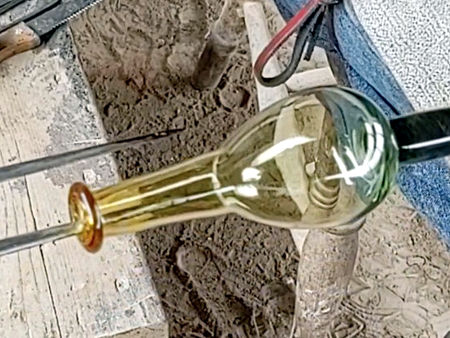
|
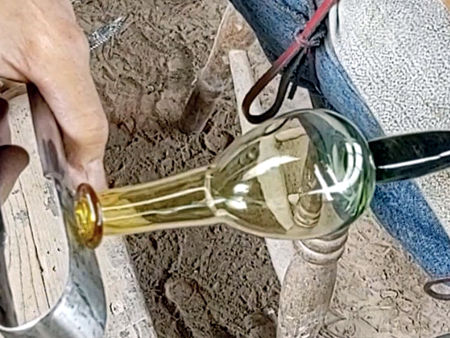
|
|
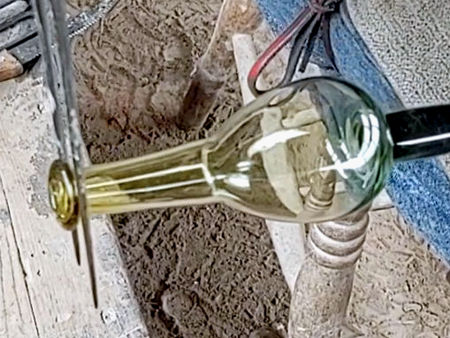
|
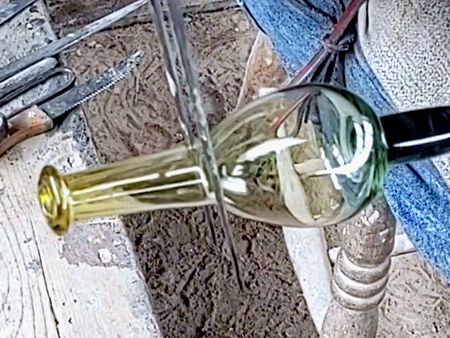
|
|
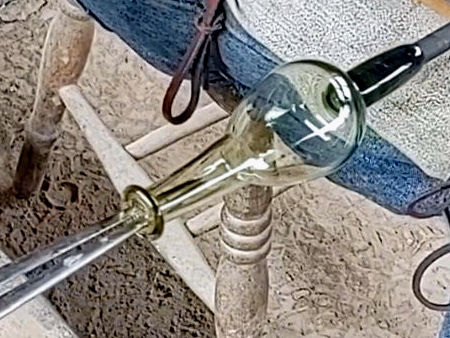
|
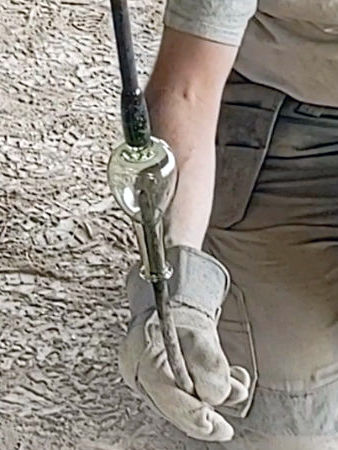
|
|
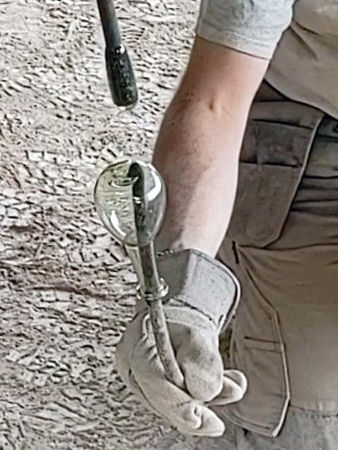
|
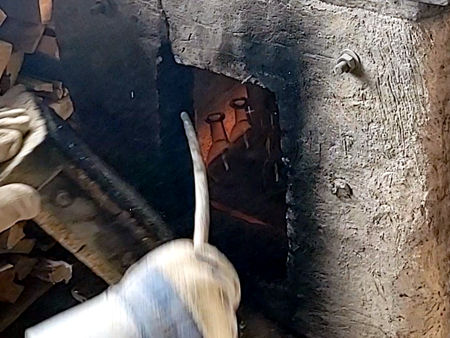
|
|
|
Storage Jar
See this page for a similar jar made during Firing Four, and this page for one made during Firing Five. These jars need a medium to large double gather in order to have enough glass to make them, and the glass needs to be well-distributed towards the base, which is why the tip needs to be cooled and shaped by marvering. Original 1st century Roman jars (in common with many other early Roman vessels) were not puntied, so tend to be thinner at the base, but we have to punty them as we do not know exactly how the Romans gripped the vessels in order to work on their rims, so, at present, we cannot emulate them. |
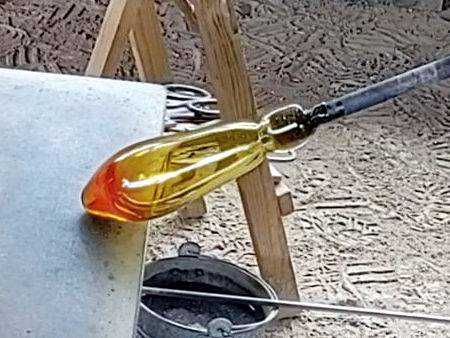
|
|
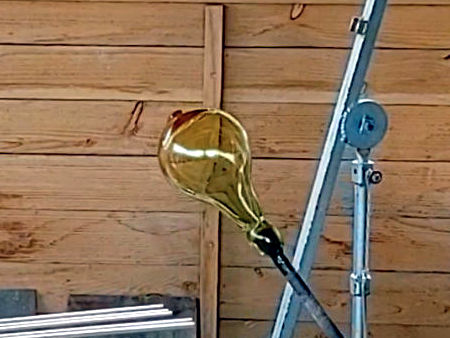
|
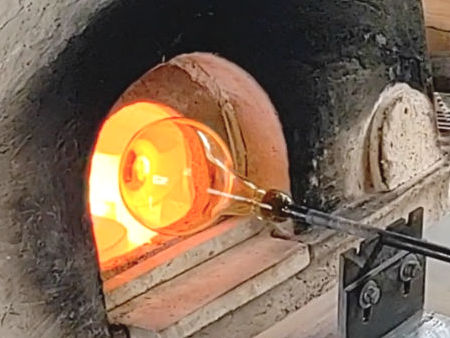
|
|
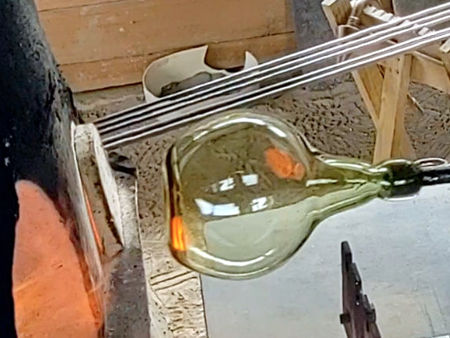
|
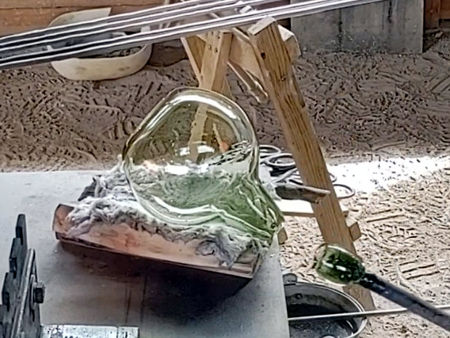
|
|
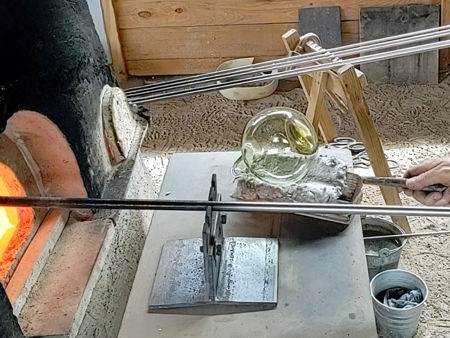
|
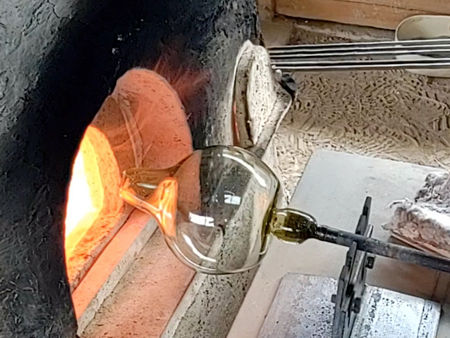
|
|
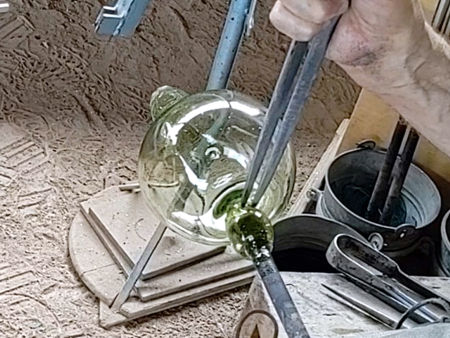
|
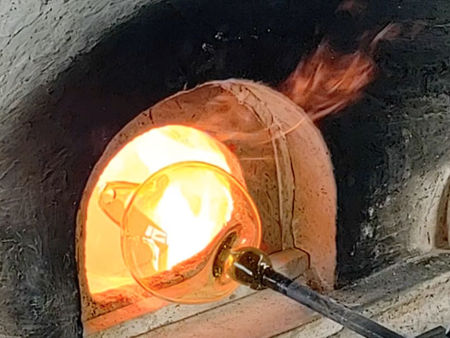
|
|
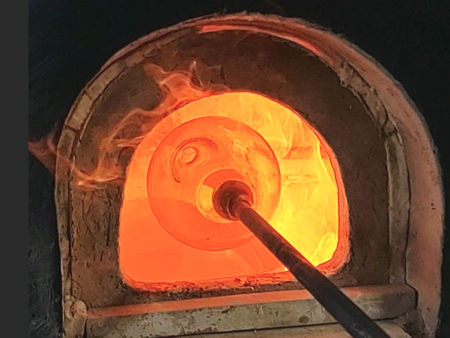
|
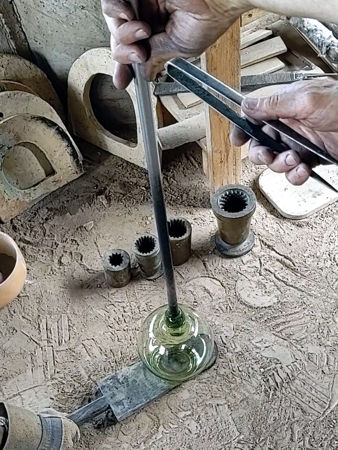
|
|
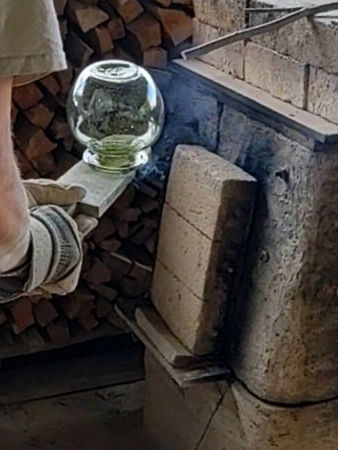
|
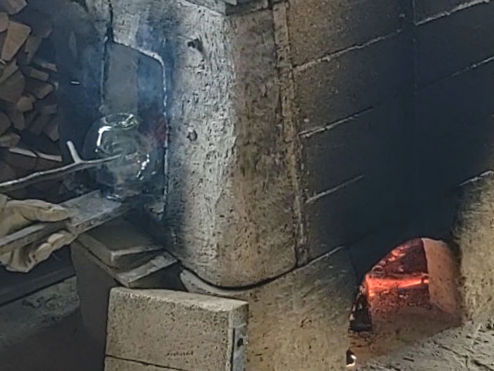
|
|
|
Trefoil-lipped Bottle
Three photos showing the lower and upper attachments, and part of the shaping of the handle. |
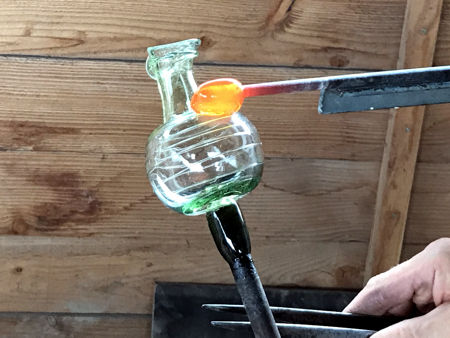
|
|
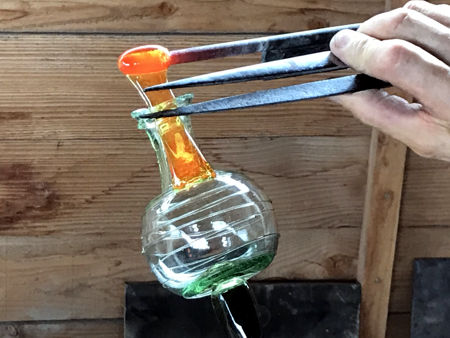
|
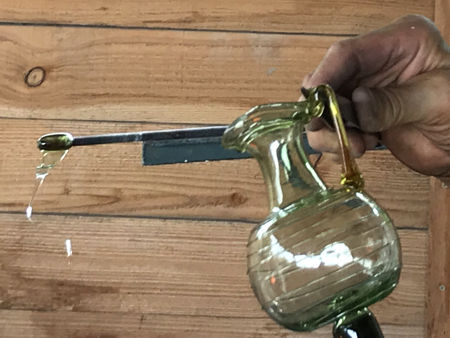
|
|
|
Two-handled Flask These 1st century vessels are unusual in that they are decorated with fragments of purple glass backed with white to enhance the purple colour (similar to some Roman Hofheim Beakers). Also see this page (and scroll down to the bottom). Picked-up and marvered decoration involves a lot of reheating to melt in the cold glass fragments and to re-establish an even temperature throughout the gather before blowing. The decoration glass can also cause the bubble to blow out unevenly - another phenomenon the glassblower has to take into account. It is usually due to the glasses not having similar compositions, or to the fact that different colours may absorb heat at different rates. |
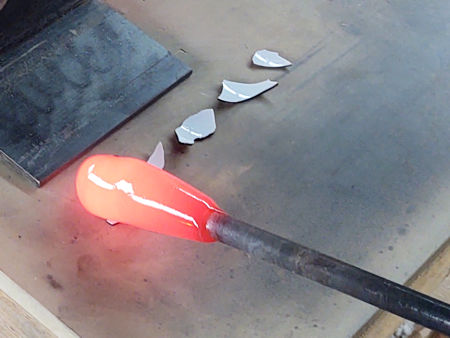
|
|
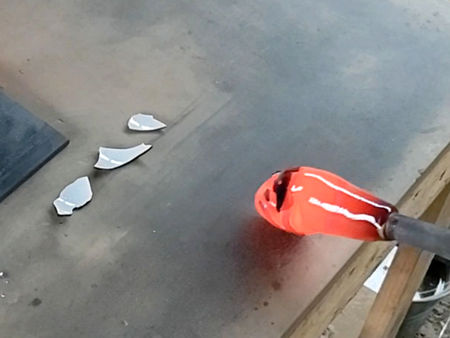
|
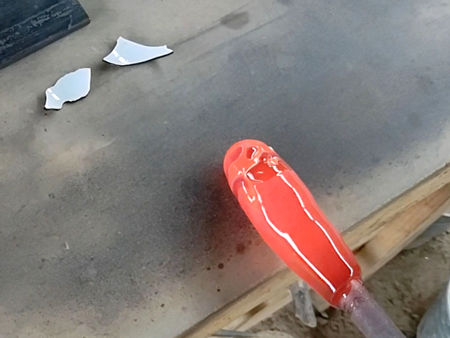
|
|
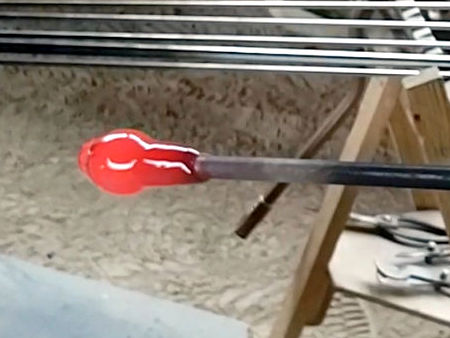
|
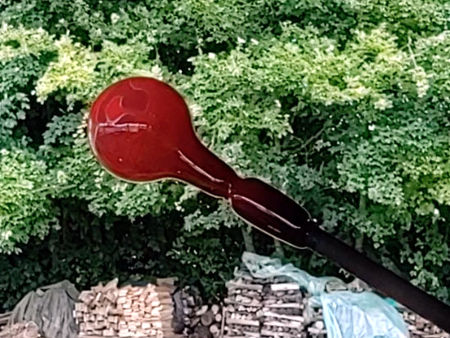
|
|
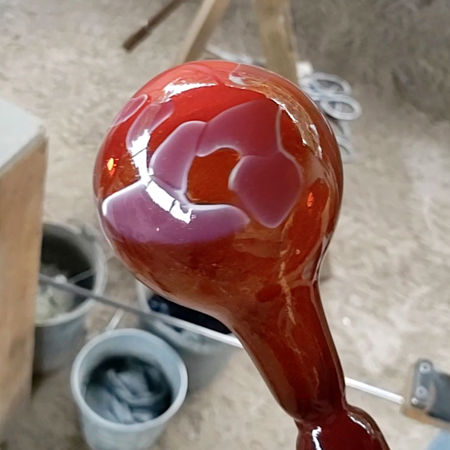
|
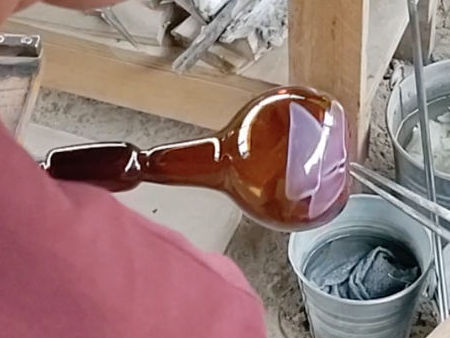
|
|
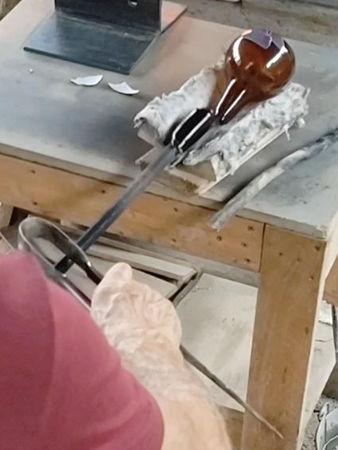
|
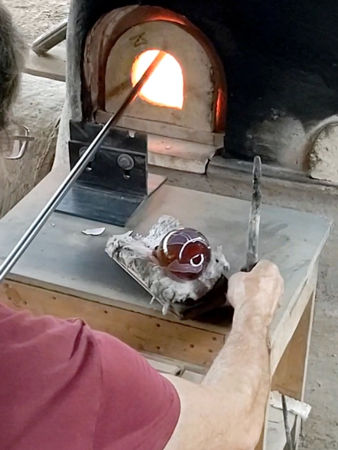
|
|
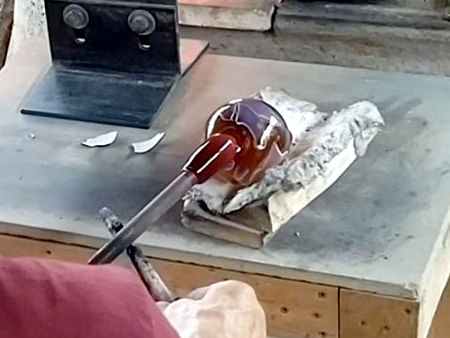
|
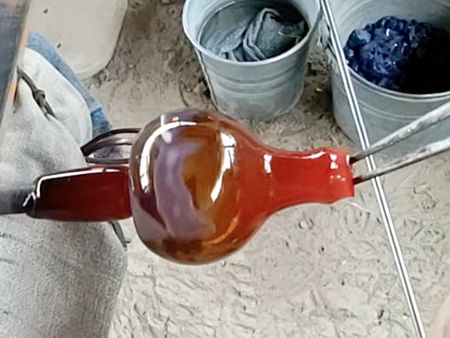
|
|
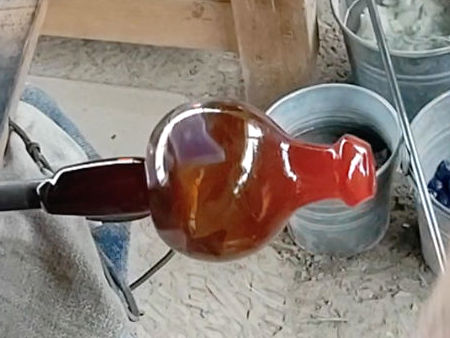
|
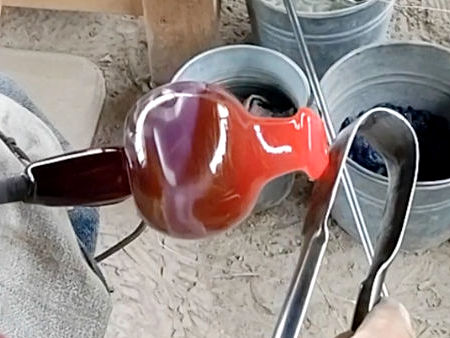
|
|
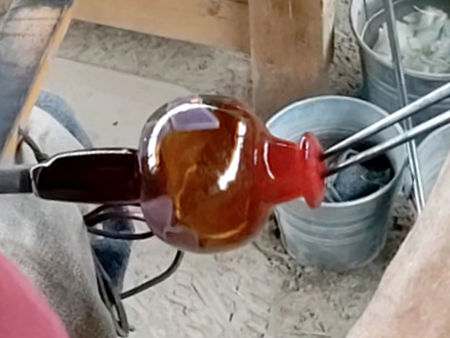
|
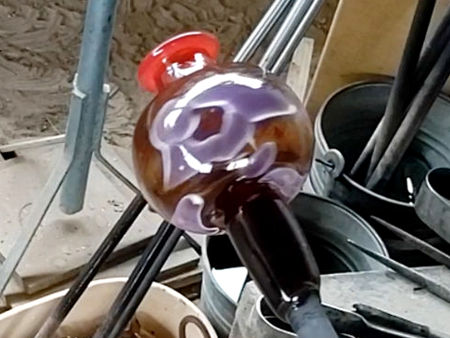
|
|
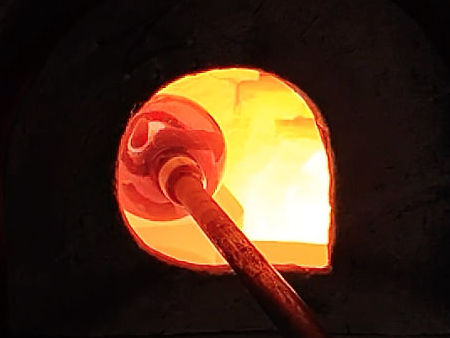
|
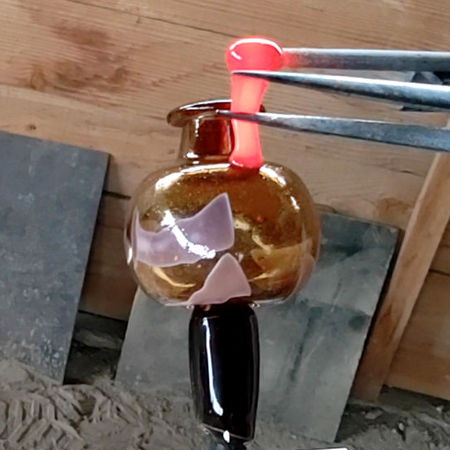
|
|
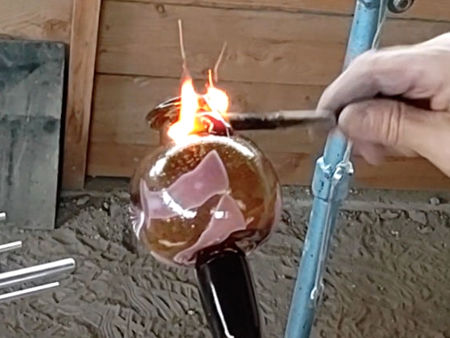
|
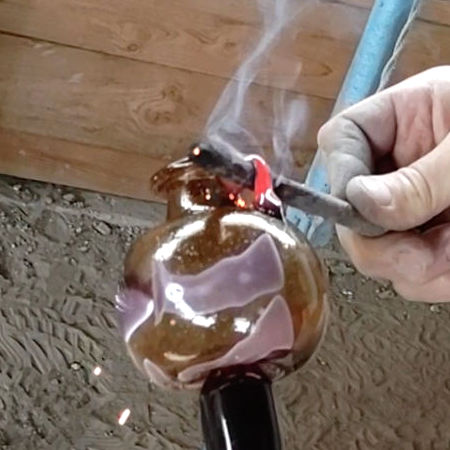
|
|
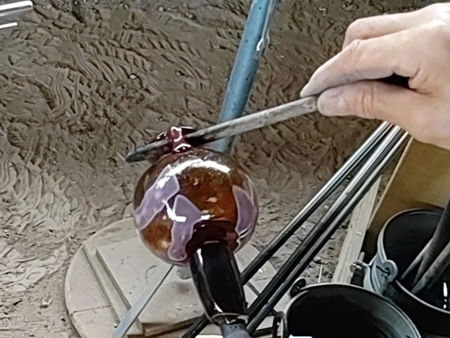
|
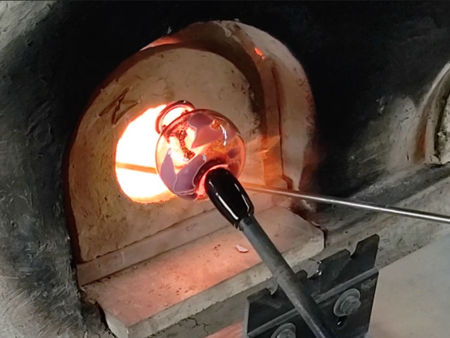
|
|
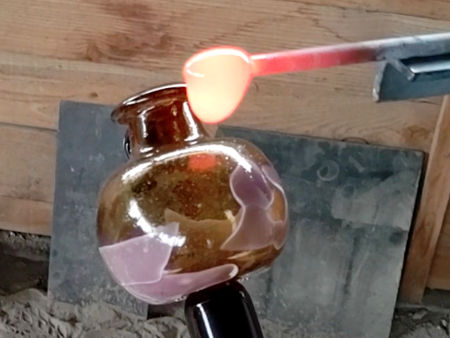
|
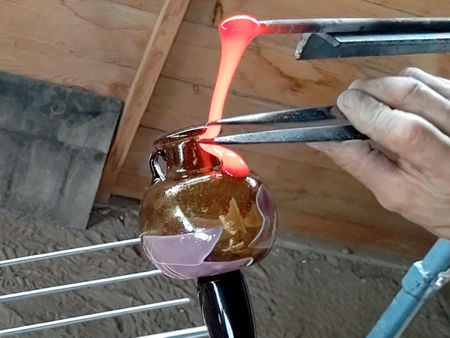
|
|
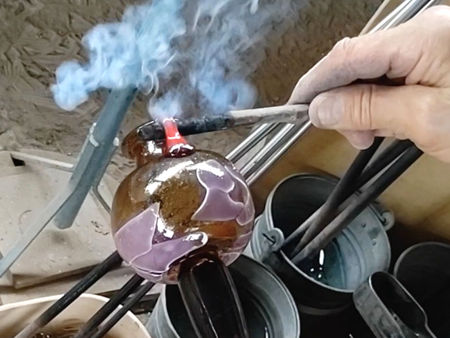
|
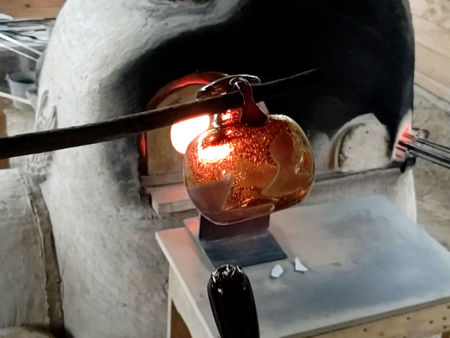
|
Home Gallery Contact Events & Projects Projects: 2019 Onwards Film & TV Archive & Links